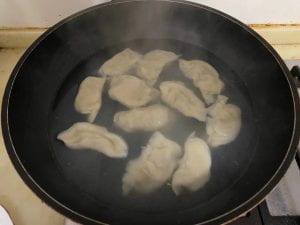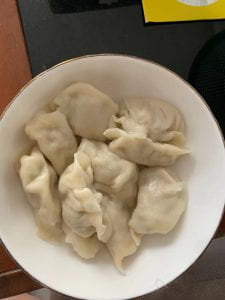General Information about Item:
- Genre: Material Lore – dish; Customary Lore – celebration, belief, superstition
- Language: English with some Chinese (Mandarin)
- Country of Origin: China
- Informant: H.S.
- Date Collected: November 23, 2020
Informant Data:
- H.S. is 48 years old. She studied at Hangzhou Law school and worked in the field of law for years. At age of 30, She became a businesswoman. She grew up in the northern part of China and currently lives in the southern part (Zhejiang province, China). Because of her experience living in the northern part, she likes dumplings, which are more popular in the North. Her family likes dumplings as well: make and eat dumplings every year during the Chinese New Year.
Contextual Data:
- Cultural Context: Dumplings are eaten during the Chinese New Year almost in all areas of China. This dish is eaten mainly because of its auspicious name and shape. Dumplings in Chinese are “jiǎozi” (餃子) and are also called “交子,” meaning the transition from the old to the new. Thus, eating dumplings is a way to celebrate this transition. Also, the shape of dumplings resembles the shape of Chinese gold ingots. Thus, making and eating dumplings also expresses the hope of gaining wealth.
- Social Context: On the Chinese New Year’s Day or the Chinese New Year’s Eve, family members gather together to make and eat dumplings together for the hope of gaining a good fortune, as well as to celebrate the transition from the old year to the new year.
Item:
- The dumpling generally consists of minced meat and finely chopped vegetables wrapped into a piece of dough skin. In China dumplings usually refers to boiled dumplings. Some people will place a coin or candy inside the dumpling in the hope of obtaining a fortune or having a sweet life, on the Chinese New Year’s Eve and special family reunions.
Image Files:

Dumplings are being cooked (Photo was taken when H.S. was cooking dumplings this year during the Chinese New Year.)
Transcript of Interview Clip:
S.T. (collector): What is one of the most interesting or important dishes that is eaten during the Chinese New Year in your family?
H.S. (informant): My mother is from the northern part of China, so as I grew up, we love cooked wheaten food. We eat dumplings a lot, and during the Chinese New year, the dumpling is a must.
S.T.: What kind of fillings do you put inside of dumplings and what kind of flour do you use?
H.S.: We normally use wheat flour and sometimes cornflour. There are lots of different fillings, like pork with different vegetables, beef, shrimp, sheep, eggs with vegetables, or even something weird like sea urchin…
S.T.: Why do you and your family eat dumplings? Any meaning or hope associated with it?
H.S.: Dumplings are often eaten during family reunions. Eating dumplings express the hope that the family members are always united. The shape of dumplings resembles the shape of Chinese gold ingots. Thus, making and eating dumplings expresses the hope of gaining wealth.
S.T.: Any custom when eating dumplings? Any tradition that you do only during the Chinese New Year?
H.S.: We sometimes place a coin or candy inside of one or two of the dumplings. Whoever gets the dumpling with the coin is the luckiest one. He/she is believed to have good fortune and sweet life in the new year.
S.T.: Do you know any folklore that is related to dumplings, since dumplings are such a representative Chinese New Year dish?
H.S.: I heard that if you don’t eat dumplings, your name will be removed with the world of the dead and the living. After you die, you will become a ghost that has nowhere to go.
Informant’s Comments:
- Making dumplings is also a social activity, during which all the family members gather together and make the dumplings. Even someone may not know how to make dumplings, but the fact that everyone is making the effort to do it strengthens the tie between family members.
Collector’s Comments:
- My family also likes to eat dumplings a lot. Every time I went back home after leaving for a while, my mother will make dumplings with me together. For me, dumplings are a symbol of family reunions. It is also interesting to hear that dumplings are also related to the afterlife. The dumplings symbolize the transition from the old to new and from life to dearth, which is like the liminality stage. The fact that we eat dumplings for the hope of gaining wealth because of the resemblance in shape is an example of homeopathic magic.
Collector’s Name: Stela (Yunjin) Tong

